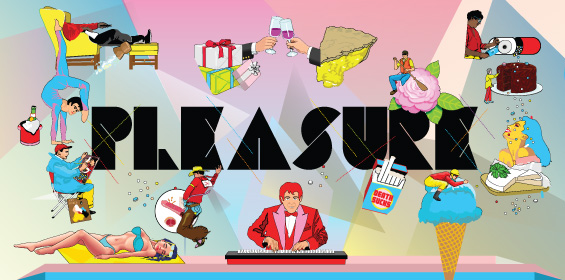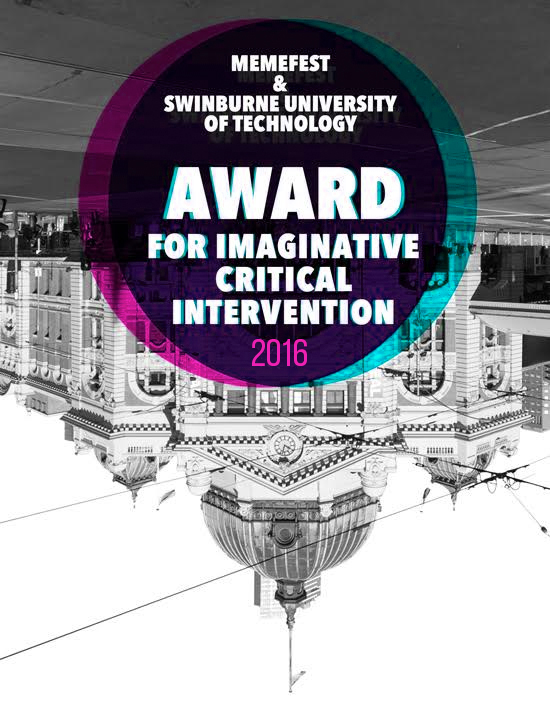Memefest PLEASURE Friendly Competition results and the Memefest / Swinburne award for Imaginative Critical Intervention

We are very excited to announce this years Memefest friendly competition results. As each year Memefest has invited the global community to engage with our special theme- this year it was PLEASURE.
Pleasure is central to our lives and communication/design and art play a major role in our relationship to it. Pleasure is an episodic phenomenon. As we all learn early on it does never really last for very long, therefore we are constantly seeking for ways to get it.
While pleasure can be used to live life fully, as well as to render people into tools it seems we rarely think of it outside its immediate effects and certainly we think even less of pleasure as social practice and something we could relate to the world in transformative ways that challenge the status quo.
Memefest 2016 is interested in pleasure in what we see as its fundamental qualities.
Pleasure is designed through visual communication/media and technology and channels into our aspirations and lifestyles. Aren’t we supposed to have pleasure all the time and does not the promise of success in life promise us a life full of pleasure? We can chose to do this, but in order to be successful we have to follow written and unwritten rules- but who makes the rules and who are the rules benefiting?
As a human experience pleasure can be an illness or a cure and many times it can be both at the same time. It can bring people together, connect them and decrease human suffering. But it can also set them apart and cause harm.
Pleasure is connected with substances- anything from food to drugs, anything we take into our bodies to experience pleasure. If you think of it- in this way we experience pleasure many times a day. But how does this make us relate to the world?
We are interested in processes where pleasure meets with conflict and especially in ways we can experience pleasure in our everyday life, which can contribute to its radical transformation towards social justice. How can pleasure transform the way we live, laugh, listen, eat, create, think, imagine, dream, work, play and relate to each other?
Two levels of knowledge production and recognition as a result of our curatorial process connect global voices and local interventions.
The theme PLEASURE was demanding and ambitious. Works submitted came from four continents and we can clearly see a younger generation engaging with Socially Responsive Communication.
Your feedback is fantastic and your works are incredibly valuable and a huge contribution to this discussion! They are very inspiring and we all can learn a lot from them.
So, results for main Memefest Friendly Competition categories are known and we are very happy to announce them. It is time to open the forum to the public. Have a look at the best works here: http://www.memefest.org/en/gallery/works2016/ Read Memefest’s official feedback on them and let us know about your perspective.
Curating and editing this year’s submission was a tough job and a big warm thank you goes to everyone who has contributed in this process!! Feedback given on works is very strong and plays a essential role in nurturing a culture of communication that goes beyond the ideology of the market. The dialogic nature of our evaluation process is designed to create the potential of going beyond the image and towards communication. Here our curatorial and editorial board members: http://www.memefest.org/en/competition/curators/ We are happy and honoured to be working with them and with many of them for a long time, which makes our collaboration even more precious.
Congratulations to everyone who participated and submitted their works- especially the highest curated ones!!
Next is our special Memefest/ Swinburne University Award for Imaginative Critical Intervention.
The Memefest/ Swinburne award for Imaginative Critical Intervention is given to support critical thinking, as the ability to see situations as they are and imagine them differently in a way that emancipates and leads to transformation through intervention. Such interventions can be many things. They create a rupture in the order of things and aim to redefine our understandings of the relations between being, doing and saying and our fields of experience. Such interventions, conditioned by critical thinking, are tightly connected to the principle of response-ability, an active position of engagement that comes with the capacity to transformatively act in situations, insisting that what matters are the human implications of our interactions and not just market imperatives.
Curated by Lisa Gye and Dr Oliver Vodeb, the recipients of the award are invited to Melbourne- Australia to take part in our in residence program.
The awards go to:
Laura Ballantyne-Brodie
Pleasure, pain and dispossession (in the Anthropocene)
Laura’s work asks us to consider how we may still find pleasure in a world where “weather no longer exists, only climate. Everything is politics. There is more plastic than fish in the ocean, chemicals in the water and ecosystem destruction at scale. There is no hope.” In the Anthropocence, she writes, “it’s necessary to consider, to imagine other ways to continue the co-evolution of the human story with Earth”. Her succinct text proposes that we need to simultaneously enter the Imaginocene, a place where we can “reimagine the narrative and ‘destiny’ of homo sapiens to use their force to recreate a world”.
We believe that Laura’s work calls for a crucial human ability, quality and a vital tool – our imagination, to become the center of our engagement with the world. As democracy is clearly mostly failing us (Billionaire Trump just became president of the USA) and climate change is according to newest research actually about to irreversibly accelerate - the Imagocene is pleasures epoch yet to come.
Laura’s work asks some vital and timely questions about where we are as a species right now. It emerges from her work as an environmental lawyer and her research focuses on an emerging systems approach to ethics, to function as a unifying foundational discipline for a nonanthropocentric (systems) approach to the environmental crisis, called Earth System Ethics. It is also tied to her activist work with Rent The World, an organization that advocates an understanding of Earth as a shared home to humanity and many other nonhuman species.
:: Pleasure, pain and dispossession in the anthropocene:: is a short poetic text that could become a manifesto. Imagine how pleasurable it will be to live in the Imagocene!
See the work here:
http://www.memefest.org/en/gallery/works2016/1856/
Lea Piskiewicz
What happened today?
Lea’s work focuses on our continued desire for interconnectedness through media but imagines a platform that is free from the current corporate surveillance aimed at increasing our already excessive consumption. What’s Happening Today is a speculative networked environment which would allow users to share one piece of media related to pleasure a day with friends and family. Over time this would build into a personal archive that could be shared with future generations. The data collected would be securely stored and distributed with tight controls but could be used to track public sentiment, with the user’s explicit consent. This, in turn, could assist in planning for futures that align with people’s desires. It also allows for intergenerational connection as users could gift their archives to their loved ones.
As a work of speculative design, Lea’s work imagines another kind of social network that, in its turn, exposes the many faults that exist in our current applications. The lack of control we currently experience over our private information rubs up against our desire to connect with each other in sometimes very uncomfortable ways. Lea’s work contributes to attempts to re-vision and reimagine the future in ways that both enhance pleasure and disrupt our cooption by government and corporate agendas.
Lea’s work is a good example of how communication design can be used outside the usual image-as-end-goal centered design culture, a culture which, although defensive of its self-importance, won’t have much to do soon, as robots, software, templates, algorithms do what designers have done in the past. The main question then will be how to go beyond the image and towards communication. Lea’s work is a good example of Design’s future.
See the work here:
http://www.memefest.org/en/gallery/works2016/1856/
Janneke de Rooij
Propaganda by the People
Propaganda by the People is a project by writer / filmmaker Arnold van Bruggen, animator Rogier Klomp and designer Janneke de Rooij. At a time of growing instability, this project invites people to contribute to a crowdsourced propaganda animation, which aims to create a new narrative about Europe from the ground up. The makers “believe Europe needs a new story. Not a new story from Brussels or one of the national governments, they failed before… A story that goes further than just the EU, but a story that brings together cultural, geographical and political Europe.”
The work opens up broader questions also for many other areas of the world, like Australia, to find new narratives that focuses on that comes from people and not politicians or the mainstream media. It also uses a tool, crowd-sourcing, in an innovative way. Rather than using crowd-sourcing for raising income, Propaganda by the People uses this tool for consciousness raising. And the rewards come from the pleasure of being able to add your own voice and your own story.
Propaganda by the People is opens an interesting perspective on propaganda as technology and as an approach to communication. Abused in the past, the “spreading of ideas” can be used for positive outcomes and if done “bottom up” and “by the people” even more so.
The project disrupts the top down manipulative power of propaganda and becomes a tool for generating ideas, producing them and contributing to the mobilization of creative workers and broader society. Congratulations, Good work!
See the work here:
http://www.memefest.org/en/gallery/works2016/1784/
+ A special recognition goes to:
Kelly Hussey- Smith and Alan Hill for their work Aura
Aura is a work of beauty. Objects bought and opened from their packaging have been treated with forensic finger print powder before photographed. The works are revealing a contradiction between capitalist commodity abstraction and intimacy. Light years apart but brought close in these photographs they suggest a very human being behind the seemingly impeccable perfection. The work is almost scary and even more so if we think about the human traces on objects we know mostly through design and image - but later they become part of our lives, the aura of labor hidden in finger prints. Still a work in development a step to consider would perhaps be a stronger focus on the fetish character of the very object, their design and meaning established through brands and the very relation between the abstract and the intimate.
Here you can see the work:
http://www.memefest.org/en/gallery/works2016/1860/
The results of the Friendly Competition and the end of our extradisciplinary Symposium/ Workshop/ Interventions sessions today, marks 15 years of Memefest. Thank you all for being part of this crazy, amazing, beautiful Journey. More soon!!


To comment, please create a Memefest account, it will take you only 2 minutes! Login here if you already have one.